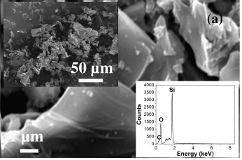For a biomaterial to be considered suitable for bone repair it should ideally be both bioactive and have a capacity for controllable drug delivery; as such, mesoporous SiO2 glass has been proposed as a new class of bone regeneration material by virtue of its high drug-loading ability and generally good biocompatibility. It does, however, have less than optimum bioactivity and controllable drug delivery properties. In this study, we incorporated strontium (Sr) into mesoporous SiO2 in an effort to develop a bioactive mesoporous SrO-SiO2 (Sr-Si) glass with the capacity to deliver Sr2+ ions, as well as a drug, at a controlled rate, thereby producing a material better suited for bone repair. The effects of Sr2+ on the structure, physiochemistry, drug delivery and biological properties of mesoporous Sr-Si glass were investigated. The prepared mesoporous Sr-Si glass was found to have an excellent release profile of bioactive Sr2+ ions and dexamethasone, and the incorporation of Sr2+ improved structural properties, such as mesopore size, pore volume and specific surface area, as well as rate of dissolution and protein adsorption. The mesoporous Sr-Si glass had no cytotoxic effects and its release of Sr2+ and SiO44- ions enhanced alkaline phosphatase activity - a marker of osteogenic cell differentiation - in human bone mesenchymal stem cells. Mesoporous Sr-Si glasses can be prepared to porous scaffolds which show a more sustained drug release. This study suggests that incorporating Sr2+ into mesoporous SiO2 glass produces a material with a more optimal drug delivery profile coupled with improved bioactivity, making it an excellent material for bone repair applications.

For a biomaterial to be considered suitable for bone repair it should ideally be both bioactive and have a capacity for controllable drug delivery; as such, mesoporous SiO2 glass has been proposed as a new class of bone regeneration material by virtue of its high drug-loading ability and generally good biocompatibility. It does, however, have less than optimum bioactivity and controllable drug delivery properties. In this study, we incorporated strontium (Sr) into mesoporous SiO2 in an effort to develop a bioactive mesoporous SrO-SiO2 (Sr-Si) glass with the capacity to deliver Sr2+ ions, as well as a drug, at a controlled rate, thereby producing a material better suited for bone repair. The effects of Sr2+ on the structure, physiochemistry, drug delivery and biological properties of mesoporous Sr-Si glass were investigated. The prepared mesoporous Sr-Si glass was found to have an excellent release profile of bioactive Sr2+ ions and dexamethasone, and the incorporation of Sr2+ improved structural properties, such as mesopore size, pore volume and specific surface area, as well as rate of dissolution and protein adsorption. The mesoporous Sr-Si glass had no cytotoxic effects and its release of Sr2+ and SiO44- ions enhanced alkaline phosphatase activity - a marker of osteogenic cell differentiation - in human bone mesenchymal stem cells. Mesoporous Sr-Si glasses can be prepared to porous scaffolds which show a more sustained drug release. This study suggests that incorporating Sr2+ into mesoporous SiO2 glass produces a material with a more optimal drug delivery profile coupled with improved bioactivity, making it an excellent material for bone repair applications.
